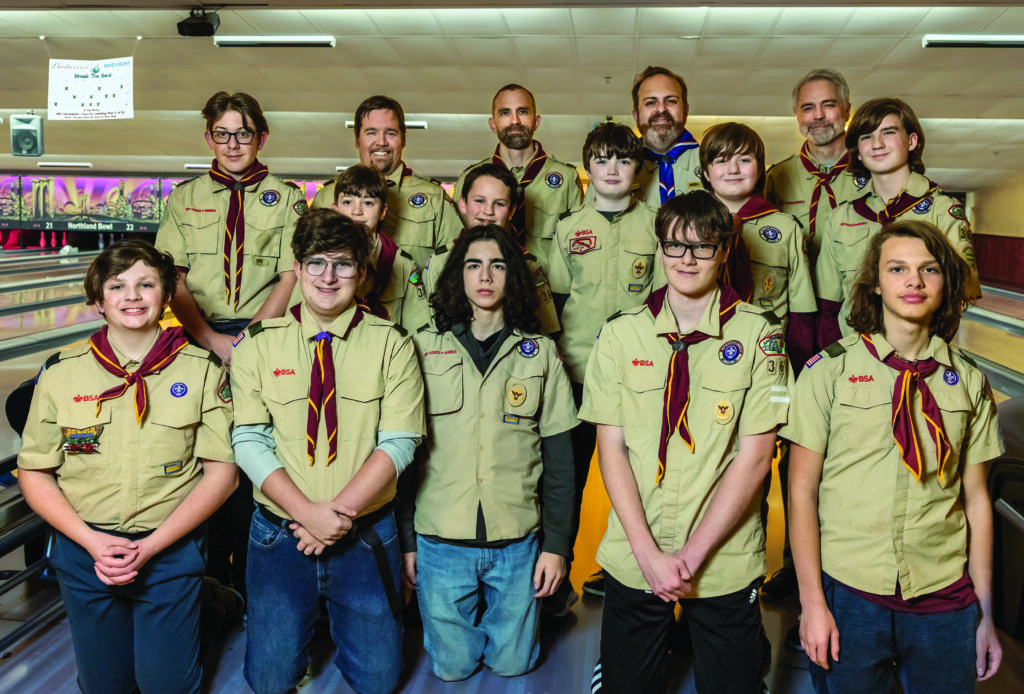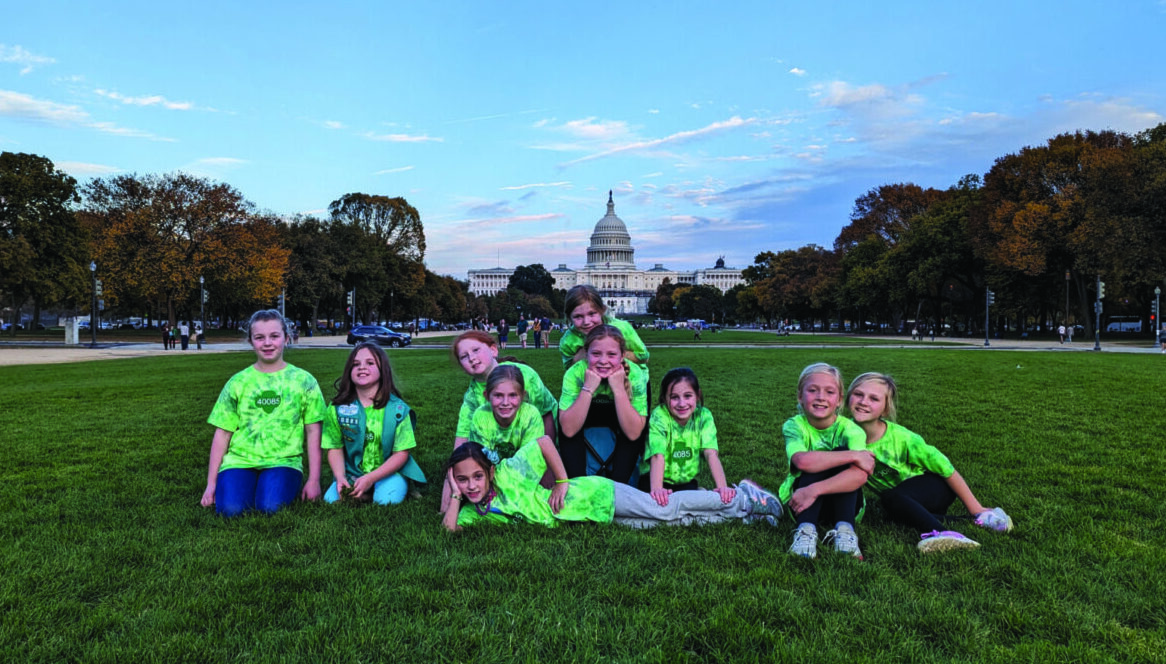Parents looking into activities for their kids have so many options these days. Starting at a very young age, there are opportunities to participate in just about every sport under the sun, plus dance and music lessons, art classes, and theater groups. But if you are looking for something a little different, something that has the potential to teach leadership development and a wide variety of life skills that could serve kids well into adulthood, don’t overlook Scouting.
When kids join either a local Girl Scout troop or a Scouts BSA (formerly known as Boy Scouts) troop, they become part of a global network with a long history.
The Scouting movement can trace its roots to England, where an official Scouting organization for boys was first established by Robert Baden-Powell in 1908, with Girl Guides following in 1910. America’s own equivalent organizations, Boy Scouts of America and Girl Scouts of the USA, were established in 1910 and 1912, respectively.
Scouts BSA celebrates the anniversary of its founding this week, Feb. 4-10, while Girl Scout Week will be celebrated March 10-16.
Today, Scouts BSA is part of The World Organization of the Scout Movement, which is found in 216 countries. Girl Guides and Girl Scouts are part of the World Association of Girl Guides and Girl Scouts and are found in over 150 countries.
Through the years, the movement has evolved to reflect the changing times, not only by adding and emphasizing modern skills in their merit badge systems—including cybersecurity, coding, and other STEM-related skills—but also by becoming more inclusive.
Globally, many of what were traditionally Scouting organizations for boys became co-ed back in the 1970s. In the United States, Boy Scouts of America welcomed females into its Venturing and Sea Scouts programs in 1971, but it was not until 2019 that girls, as well as LGBTQ+ youth, were permitted to join the traditional Scouts BSA program. Girl Scouts USA has welcomed all who identify as girls, regardless of sexual orientation, for a longer time frame.
While both the Girl Scouts and Scouts BSA organizations have seen their share of changes, “The core tenets—character building, environmental care, volunteerism, and outdoor skills—connect Girl Scouts or Girl Guides and Boy Scouts all around the world,” says Eric McGinnis, committee chair of Troop 367, a boys’ unit in Scouts BSA. “The Scouting movement that started 115 years ago has really remained somewhat consistent, and part of that consistency is because those core tenets have stayed quite true.”
McGinnis knows what he is talking about. An Eagle Scout himself, McGinnis focused his doctoral research on organizational leadership within the global scouting movement, receiving his doctorate in 2020.
Life skills and leadership
The entry into Scouts BSA typically begins at the Cub Scout level, which is for kids in kindergarten through fifth grade. Cub Scouts are organized geographically in packs, which are made up of smaller dens by grade level (Lion Cubs, Tiger Cubs, Cubs, Webelos, and Arrow of Light). Cub Scouts work to earn badges and participate in friendly competitions like the Pinewood Derby, in which Scouts race miniature cars that they design and fashion from a block of wood.
After Cub Scouts comes the traditional program most people are familiar with: Scouts BSA for ages 11 to 17. At this level, Scouts are organized by troops, which are no longer strictly geographical; Scouts choose the troop they would like to join. Girls’ troops are separate from boys’ troops, but they often collaborate on projects and other activities.
For ages 14 to 20, there are also Venturing and Sea Scouts programs, which are completely co-ed and which focus on high-adventure outdoor activities or boating skills.
The Scouts BSA program focuses on traditional Scouting skills like knot-tying, outdoor activities like camping and hiking, and advancement through the earning of merit badges.
“All of those outdoor things really still sit as the ‘hook’ for the program, but, ultimately, they are processes to engage youth and adults in a shared space in ways that teach character and stewardship for other people, as well as stewardship for the environment,” explains McGinnis.
However, he says, some troops focus more on outdoor skills than others do. His own troop is more interested in volunteerism, for example, and he says they choose to host a Mario Kart tournament as a recruiting event, rather than a more traditional outdoors gathering.
As Scouts progress through the ranks, the focus begins to shift towards leadership development and community service, culminating in the highest rank: Eagle Scout.
To earn Eagle, Scouts must earn twenty-one merit badges, including four citizenship badges. Three of those—citizenship in the community, citizenship in the nation, and citizenship in the world—have been required for many years. The fourth, citizenship in society, was added in 2022 and mainly focuses on diversity, equity, and inclusion. Other required badges focus on everything from first aid to personal fitness to financial literacy.
The path to Eagle also requires the Scout to take on leadership roles within the troop. Finally, after approval from the district and national organization, the prospective Eagle Scout must prepare and execute a service project.
“Those projects require some rigor, and it is 100 percent the Scout running it—not necessarily doing all of the work, but they are delegating and leading and making mistakes along the way,” explains McGinnis. “This provides a bit of a social sandbox to be able to figure a lot of this leadership stuff out in a safe and supportive environment.”
Abby Serefine of State College became part of the first class of female Eagle Scouts in the nation in 2021. She and her brother, Peter, completed their Eagle Scout projects together at Shavers Creek Environmental Center. Abby built and installed birdhouses for chickadees and bluebirds, who had been struggling to find appropriate nesting areas. Peter’s project involved clearing out Bluebird Meadow, which had become overgrown with invasive plants, and clearing out areas for Abby’s birdhouses along Bluebird Trail.
Abby says joining Scouts BSA was a dream come true for her, after spending much of her childhood following her brothers through their Scouting journeys. She had tried Girl Scouts, but it just wasn’t for her, she says.
“Whenever someone asks why I’d join Boy Scouts when there are Girl Scouts, they are not understanding that they’re completely different programs,” she says.
She joined a Venturing Crew at age 14, and then, along with four other girls, Abby joined Troop 31G on February 1, 2019—the very first day that BSA admitted females to membership. With Eagle in her sights, Abby quickly worked her way up the ranks, taking on leadership positions like senior patrol leader within her troop, before capping off the effort with her project.
Being a groundbreaker was not necessarily easy, however.
“There was a lot of backlash, I’m not gonna lie,” Abby admits, but says she was able to ignore the negative voices because “my troop was made up of the most supportive people.”
Of Abby and all of the first female Eagle Scouts, McGinnis says, “If I was on a hiring committee for any leadership position, I would hire them without even talking to them. Because that takes something special. … I am so impressed with the women that were able to do that, despite unfriendly comments from people who were afraid of change.”

Beyond cookie sales
Girl Scouts may be known and beloved for Thin Mints and Samoas, but Jennifer Black, troop leader of her daughter Amelia’s Brownie/Junior troop, Troop 40085 in State College, would like people to know that the Girl Scout experience is “definitely so much more than cookies.”
Cookie sales can be important, though, as they help support troop activities, like traveling to Savannah, Georgia (the birthplace of Girl Scouts of the USA), and going on camping trips.
Like Scouts BSA, Girl Scouts begins in elementary school, and troops are generally organized geographically, especially at the younger levels. Girl Scouts start with Daisies in kindergarten, moving on to Brownies, Juniors, Cadettes, Seniors, and Ambassadors.
Each Girl Scout troop determines its focus and activities based on the group’s interests, and Black says her daughters’ troops have been fortunate to have some fun experiences, including holding the flag during the national anthem at a Penn State football game and taking a curling lesson in Altoona.
Like BSA, Girl Scouts emphasizes earning badges. The organization has recently added more current STEM-based badges, but other badges focus on things like outdoor exploration, conservation, crafts, and even mental health. Girl Scouts are welcome to work toward older, “retired” badges as well.
Girl Scouts work toward awards as a way to encourage community service and develop leadership skills. Bronze Awards are earned by Girl Scout Juniors (fourth- and fifth-graders) as a troop, while Cadettes (sixth- through eighth-graders) can achieve Silver Awards either in groups or as individuals. Both involve completing a Girl Scout “journey”—a deep dive into a chosen topic of interest—and identifying a community need, making a plan to solve it, and putting that plan into action.
Girl Scout Seniors or Ambassadors (ninth- through twelfth-graders) can work to achieve the highest award, the Gold Award. This involves many of the same steps as the Bronze and Silver Awards but requires more involvement with community leaders and experts and a more intense level of commitment.
The key for all of the awards is to make sure the chosen project is sustainable, Black says—“Not something you do once and it’s done. It has to be something you know is going to last.”
Abby Weiser of Troop 40024 in Bellefonte achieved the Gold Award last year. She spent over 115 hours designing and renovating a playground at St. John Catholic School, which involved coming up with creative ways to transform the parking lot and its walls into an interactive play space using almost nothing but paint.
Leading a team of family members, troop members, and high school friends, she created a colorful play space including eleven painted playground games, a wooden water bottle holder, and a miniature village.
“I really wanted to leave my mark on St. John’s and on Bellefonte in general as much as I could as I move on to my next chapter,” Weiser says. “I think it was something they needed, and they didn’t really know how much they needed it.”
Personal impact
Besides leaving a lasting impact on the community, both the Scouts BSA and Girl Scout organizations can have a positive impact on the youth who participate in them.
Now a student at Massachusetts College of Art and Design, Serefine says, “I really, really appreciate everything Scouting did for me. My brother and I have noticed that our friends who didn’t do Scouts can’t do some of the things we learned, like cooking. I have all these weird, niche life skills I wouldn’t have picked up otherwise. It has really helped me in that sense, and in a social sense, and in knowing how to plan and set goals for myself.”
Weiser is a freshman majoring in theatre arts management at Slippery Rock University. She says she would encourage girls to not only join Girl Scouts but to stick with it.
“You learn so much about things you need throughout life, like first aid, camping skills, finance. You learn things in Girl Scouts that you don’t learn in school.” Weiser says. “It looks great on resumes, but also, I’ve met some of my closest friends through Girl Scouts.” T&G
Karen Walker is a freelance writer in State College.



